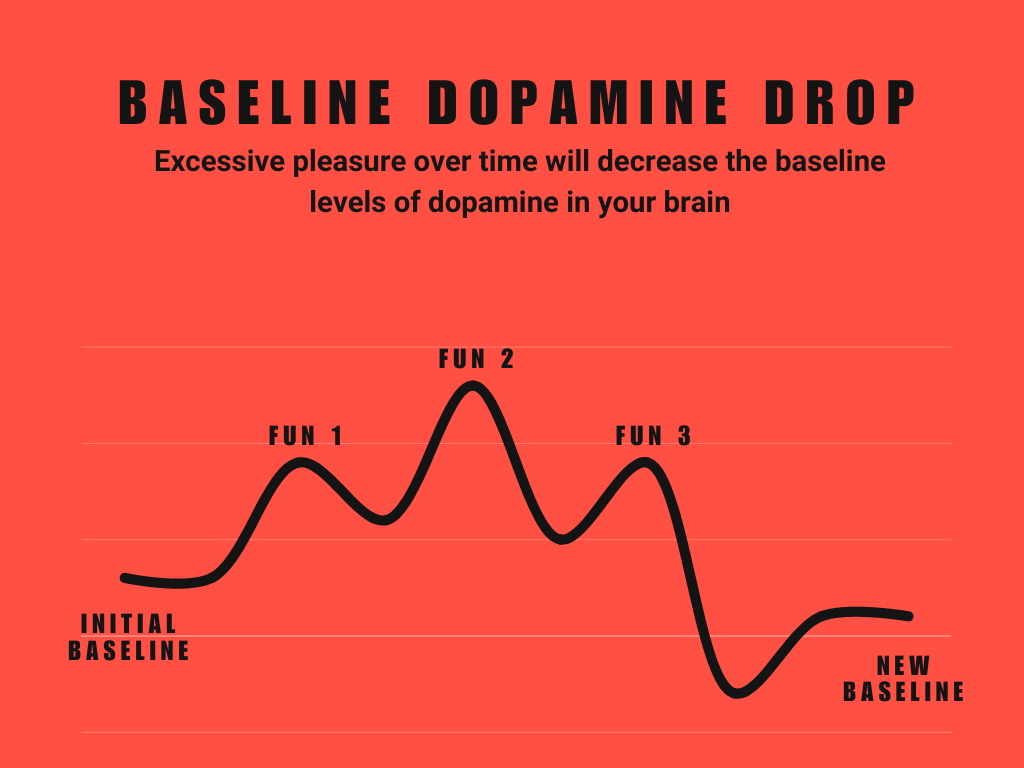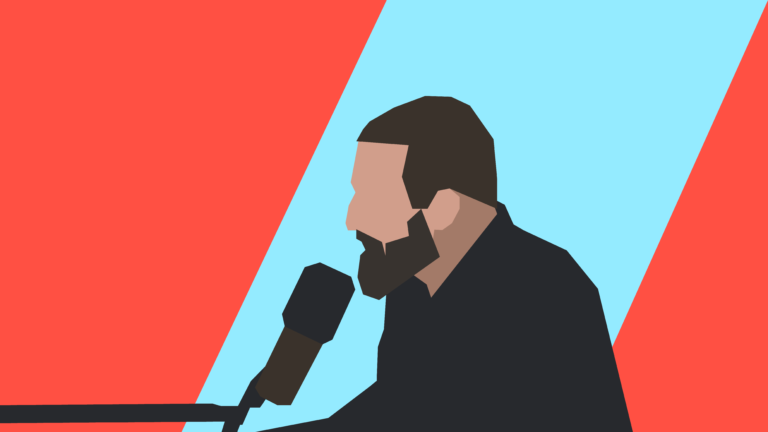Jump to Content
Top 5 Things You Need to Know About Dopamine (Recommended).
You can’t control dopamine to always stay motivated if you don’t even understand how it works. Broadly speaking, dopamine is a neurotransmitter that plays a crucial role in motivation, reward-seeking behavior, learning, focus, and movement.
It’s a vast topic, but only so much that is important for us to know, most of which is related to motivation. So, here are the top 5 most important things to know about dopamine:
1. Interestingly, Dopamine Release Peaks When a Reward Is Anticipated, Rather Than When the Reward Is Actually Obtained.

Here’s why:
- It’s released when you receive a reward to reinforce the behavior that led to it, making you more likely to repeat that behavior in the future. This way, dopamine aids in learning and repeating behaviors that result in positive outcomes.
For example, when I finally got good grades in a school test, I felt happy and a dopamine spike was responsible for that happiness. The dopamine was attempting to reinforce the behavior that led to my academic success (albeit unsuccessfully). - During the anticipation phase, dopamine is released to motivate us to engage in behaviors associated with the expected reward.
When you encounter a cue or context that is associated with a rewarding experience (the smell of pizza, the sound of a notification, or the sight of your crush), our brain predicts the future reward (tasty pizza).
The dopamine release encourages us to take action to get that reward (buy that tasty pizza).
And as you pursue the reward, dopamine continues to release in response to each step you take toward obtaining it, creating a feedback loop that keeps you at it.
2. Dopamine Spikes Are Followed by a Dopamine Crash, Causing Levels to Dip Below the Baseline (Where They Were Before Being Elevated by That Delicious Pizza).
So, after a great workout (you broke all your personal records), you’ll stay high on dopamine for a while until it crashes, making you feel unmotivated, giving you feelings of fatigue, or even irritability.
This happens due to two main reasons:
- The brain’s effort to achieve a balanced state, known as homeostasis. And the crash is proportional to the spike (the more intense the fun, the longer you’ll stay demotivated afterward). It does it to maintain stability and prevent excessive stimulation.
- If dopamine levels remained elevated, we will become complacent and less motivated to seek out new rewards. Simple logic, if you’re always happy, you wouldn’t want anything else.
The crash creates a sense of “wanting”, asking us to bring dopamine levels back up again.
3. Learning and Adaptation Are Closely Linked to the Dopamine System.
Dopamine helps your brain learn the cues or behaviors that lead to good outcomes and motivates you to do those things again later.
For instance, let’s say you spot a new fruit on a tree. At first, you might hesitate to try it, but eventually, you give it a shot. And surprise! It’s actually a super tasty and nutritious fruit. Your brain gets the memo, so the next time you see that fruit (or even hints of the tree), your dopamine goes a little wild (spikes).
4. Reward Devaluation: A Previously Enjoyable Thing Loses Its Charm, and It No Longer Brings You the Same Pleasure as It Did Before.
So, if something keeps spiking dopamine repeatedly, your brain eventually says, “that’s enough.” Like, I don’t get the same joy from listening to music while working out anymore (so I’ll take a break from it to relish it again, sort of like a dopamine detox).
But why does the brain do this? Two main reasons:
- When the brain senses that a reward is easily available and abundant, it lowers the dopamine response connected to that reward. After all, there’s no need to keep you motivated to attain something you already have plenty of.
- It’s the good old homeostasis at play once more. This is to keep everything balanced and avoid overstimulation. The brain doesn’t want its “dopamine reserve” to run empty.
5. Excessive Pleasure Over Time Will Decrease the Baseline Levels of Dopamine in Your Brain, Leading to Feelings of Being Unmotivated.

Too many “hits” of dopamine will cause a big crash. This sets off a challenging cycle in motion: you’ll start craving that “high dopamine” state again, leading to consuming more stimuli to regain that sense of feeling good.
For instance, consider the aftermath of a lively party. The subsequent dip in dopamine will leave you feeling unmotivated and generally low. This will make you to engage in actions like repeatedly checking social media, sipping sugary drinks or alcohol, or smoking – all in an attempt to restore dopamine levels.
These actions cause dopamine to spike again, only to be followed by yet another crash, and the cycle continues.
So, to avoid falling into this detrimental loop, which lies at the core of procrastination, follow these tools to always stay motivated through dopamine control.
18 Tools for Dopamine Control (For Constant Motivation).
Here’s what your day might look like, step by step, to manage your baseline levels of dopamine and stay motivated throughout the day. We’ll start from the morning and go all the way to bedtime.
1. After Waking Up: Never Miss Early-Morning Sunlight.
Catching the morning sunlight is a surefire way to boost your dopamine and cortisol levels. We get why having a higher baseline dopamine is crucial, but what about cortisol?

Having elevated cortisol levels in the morning not only wakes us up but also amps up our energy, regulates metabolism, reduces inflammation, enhances cognition, and fine-tunes our internal clock. It’s like getting some added perks with your dopamine recharge.
Making this a consistent habit can even lead to an increase in the activity of certain genes responsible for coding dopamine receptors, effectively multiplying the number of dopamine receptors in your brain.
On clear mornings, spend 5–10 minutes in the sun, letting its rays touch your face without direct eye contact. On cloudy days, extend this to 10–30 minutes, facing east. Remember to skip the sunglasses. Aim to do this within 15–20 minutes of waking up to reap the most benefits.
Note: Try to view morning sunlight most days, if not every day.
2. Breakfast (Or Lunch/Dinner): Eat Foods Rich in Tyrosine.
L-Tyrosine is an amino acid precursor to dopamine. Eating foods rich in tyrosine or taking L-tyrosine supplements can provide the building blocks needed for dopamine synthesis.
Here are some foods high in tyrosine, ranked in descending order from highest to lower quantities of tyrosine:
- Soy Products: Foods like soybeans, tofu, and soy-based products are rich sources of tyrosine.
- Lean Meats: Lean meats like turkey, chicken, and lean cuts of beef contain significant amounts of tyrosine.
- Fish: Fish such as salmon, trout, and tuna are good sources of tyrosine.
- Dairy Products: Dairy items like yogurt, cheese, and milk also provide tyrosine.
- Eggs: Eggs are a source of tyrosine and other essential amino acids.
- Seeds and Nuts: Almonds, pumpkin seeds, and sesame seeds are examples of seeds and nuts with tyrosine.
- Legumes: Lentils, beans, and peas are legumes that contribute to tyrosine intake.
- Whole Grains: Quinoa, oats, and whole wheat products contain tyrosine as well.
3. Morning (Or Anytime During the Day): Get Enough Vitamins (& More).
Lower levels of vitamins such as vitamin D, B5, B6, magnesium, and omega-3 fatty acids can impact dopamine production.
Here’s what to eat more of:
- Vitamin D: Fatty fish, egg yolks, milk, and orange juice.
- B5: Avocados, mushrooms, sweet potatoes, and sunflower seeds.
- B6: Poultry, fish, potatoes, bananas, and chickpeas.
- Omega-3 fatty acids: Flaxseeds, chia seeds, walnuts, soybeans, fatty fish like salmon, tuna, and mackerel.
- Magnesium: Nuts (cashews, almonds), legumes, dark green vegetables (spinach, broccoli), seafood, whole grains, and dark chocolate.
4. Morning (Or Anytime During the Day): Control Stress.
When you’re stressed, your body releases “fight or flight” hormones like cortisol and adrenaline. This exists in us to help us survive (like everything).
However, elevated cortisol levels have been associated with reduced dopamine receptor sensitivity, meaning you’ll need to eat 6 chocolate chip cookies to get the same pleasure you usually get from 2.
I try to control my stress through many activities like guided meditations (I use the app Balance, my other favorite is Headspace) which help me practice observing my thoughts and feelings non-judgmentally (like I’m observing myself from a third-person perspective), helping me deal with them effectively.
And it really works. Andrew Huberman coined the term NSDR (Non-Sleep Deep Rest), which includes techniques that basically recharge you to help you do creative work better. It can also help you with stress, so here are some free 10-20 minute sessions for you to try.
Other ways I control my stress include cardio (running for hours), weight lifting, socializing, watching comedy, reading books, and telling myself the truth about the positives of life (reasoning with myself through dialogical thinking). Just anything that takes my mind away from the real problems of life for a while.
5. Before Work (Main Productive Task): Don’t Reward Yourself Before a Task.
Should you indulge in something enjoyable, like watching a fun YouTube video, just before starting a workout? Not the best strategy.
The brain has a tendency to compare tasks, creating a sharp distinction between the pleasurable experience of a prank video and the perceived effort and potential challenge of a workout. Consequently, the workout may seem significantly more demanding in contrast, leading to reduced motivation compared to if you hadn’t watched the prank video.
Two simple reasons explain this occurrence:
- There’s a disparity in the dopamine released during these two activities (a prank video triggers a more immediate dopamine release compared to a strenuous workout). Our brain tends to draw comparisons between activities.
- The dopamine spike resulting from the prank video will be followed by a subsequent crash. As you’re now aware, during this crash, you’re likely to feel unmotivated.
The variance in dopamine levels between activities and the subsequent dip in dopamine levels following a pleasurable activity collaborate to give rise to the contrast effect.
6. During Work: Add Add-Ons (Enhancements) Intermittently.
You can use this hack to stay motivated for your favorite productive task. To maintain motivation during repetitive productive tasks, finding intrinsic motivation is crucial.
However, adding a pleasurable add-on to a productive task intermittently can help keep your brain engaged and motivated by providing higher dopamine at unexpected times. This mirrors how social media and games keep users engaged.
Focus on the word ‘intermittently.’ Meaning without a pattern, randomly. Avoid adding dopamine-spiking add-ons to your tasks every time, as dopamine release becomes linked to the reward rather than the task itself.
This leads to requiring bigger and bigger add-ons (motivation) to complete the same task next time, as your brain’s dopamine receptors become desensitized to that reward. Why? Refer to point 4 of the intro.
To decide when you should add something enjoyable to a task, you can toss a coin or use this website to randomly decide whether to add a big, small, or no add-on to the task.
Here are some examples of adding add-ons to productive tasks (copied from my ‘Rules for Planning Your Day‘ article):
- Listening to music while working out.
- Choosing an energy drink instead of water while working out.
- Listening to focus music or soundscape music while writing, reading, or studying.
- Having tea/coffee while working.
- Doing work with your friends.
- Working on a project together with your friends in nature.
7. During Work, II: Stop Multitasking.
This isn’t something I learned from Andrew Huberman, but from another neuroscientist known as Daniel Levitin. It’s worth sharing.
Basically, what happens is that when we multitask, our brain finds it very stimulating, giving us a sense of accomplishment and releasing dopamine. This reinforces this behavior, creating a feedback loop that effectively rewards the brain for becoming distracted and for frantically looking for outside stimulation.
This one was tricky for me to spot, as you feel like you’re working, but you’re just spiking your dopamine like a cocaine-addicted lab rat, only to feel worthless after the crash.
8. During Work, III: Train Your Brain to Reframe Your Relationship With Effort, Strain, and Deprivation.
Dopamine is subjective, so I might get a spike from watching a boring 3-hour interview, but for others, it might only be pain.
One more thing you should know about dopamine (maybe you’ve already guessed it by now): Dopamine released from “good” activities like working out is gradual and consistent, and it’s different from the rapid short-term spike you get from “bad” activities like using social media.
The crash from “good” activities is less drastic, and other activities seem less boring in comparison. This sustained release reinforces the idea that the process and effort are rewarding, leading to a more lasting sense of pleasure and motivation.
So, you can tell yourself the truth and convince yourself that effort and deprivation are good for you. For example, I enjoy the pain lifting weights causes, so I don’t work out just to get the reward (strength, endurance, appearance) but also because I’ve developed a good relationship with the effort itself over time. It makes me feel good in the present.
Andrew Huberman explains the same topic through intermittent fasting. Some people who practice intermittent fasting report that they find enjoyment in the fasting state itself. They evoke dopamine from tracking their fasting time and deriving a sense of accomplishment from the effort they put into fasting.
So, try focusing on getting the intrinsic motivation from the effort itself, convince yourself with reason and facts why it’s good for you (don’t lie to yourself), and focus less on the chocolate brownie you’ll get to eat later.
9. After Work: Don’t Reward Yourself Immediately After a Task.
If you consistently treat yourself to a reward right after completing a task (like watching a movie immediately after finishing your workout), your brain begins to anticipate the reward.
Consequently, the release of dopamine becomes associated more with the reward itself rather than the task you completed. This shift leads to a reduction in dopamine release during the task, since the focus has moved from the inherent value of the task to the external reward.
Instead of immediately reaching for your phone or watching a movie right after your gym session, it’s beneficial to create a time gap before indulging in such activities.
Aim for at least 15 minutes. During this interval, you can accomplish tasks like doing the dishes, tidying up your room, taking a less enjoyable shower (with colder water), cleaning your earplugs, preparing a meal, and more.
10. Evening (Or Anytime During the Day): Immerse yourself in sensory-rich environments.
Being in environments that are full of novel sensory experiences can boost the release of dopamine in the brain.
For example, spending time in nature or hanging out in vibrant cities where there is a lot to see, hear, and experience can trigger the brain’s reward system.
I suggest doing this in the evenings, as you can pair it with observing evening sunlight. Evening sunlight is equally crucial and potent for activating the biological circuits that bolster mental, physical health, and immunity—this remains true even on cloudy days. Consider taking an evening walk to immerse yourself in a sensory-rich environment while soaking in the evening sunlight.
11. Night: Avoid Excessive Melatonin.
Steer clear of melatonin supplements, as they can cause a drop in dopamine levels and disrupt your regular sleep cycles.
Melatonin has a hand in how our heart and body manage things, which can result in a decrease in dopamine availability. Save melatonin for jet lag situations.
12. Before Bed: Reduce bright light exposure at night.
Bright light exposure between 10 PM and 4 AM can significantly decrease the amount of dopamine in your brain for days.
Best practices to follow include: Dimming the lights, using warmer and softer lighting, reducing screen time before bed, using night mode (yellow filter) on devices at night, using blue light blocking glasses, and positioning lights lower in the room (since the lower part of the eyes is more responsible for sending wakeful signals to the brain, hence the morning sunlight coming from above and hitting your lower eyes).
13. At Bedtime: Sleep and Wake Up at the Same Time Every Day.
An inconsistent sleep schedule is difficult for your body to adjust to, disrupting your body’s natural sleep-wake cycle and affecting dopamine levels in the brain.
While it’s not necessary to wake up and go to sleep at the exact same time every day, you should try to maintain a consistent timing that revolves around a similar schedule.
14. At bedtime, II: Sleep Enough (Lack of Sleep Destroys Dopamine).
A study published in the Journal of Neuroscience found that sleep deprivation downregulates dopamine D2R in ventral striatum in the human brain. Many similar studies support this finding. So, aim for 7–9 hours of sleep every day to avoid destroying your dopamine levels.
Time-Independent Tools.
15. Avoid Layering Too Many Sources of Dopamine.
Enjoy watching your favorite TV show while it’s snowing, sitting in the most comfortable position with a blanket and a heater, and sipping on a cup of tea (or coffee)? Me too. However, by now we know layering too many sources causes a huge spike in dopamine, which results in a bigger crash afterward.
Your dopamine will take more time to come back, since the spike (and the crash) was huge, leaving you unmotivated for hours. This unmotivated state will force you to take bad decisions (like procrastinating and drinking an energy drink with enough sugar for ten people instead).
So, a good rule of thumb is to avoid more than one-two sources of pleasure (maybe just the TV show, or perhaps the heater as well).
You can always have more fun if you’re willing to put in the effort to recharge your dopamine. Here are 8 ways to recover your dopamine faster.
16. Exercise (For Not-So-Obvious Reasons).
Here are a few not-so-obvious reasons to exercise:
- Regular exercise has been shown to increase the sensitivity of dopamine receptors. This means that even moderate amounts of dopamine release can elicit a noticeable response (there’s no need for extremely high levels of dopamine to experience pleasure or motivation).
- Regular exercise has been linked to the production of new neurons in certain brain regions, including those involved in motivation.
- Chronic stress can disrupt dopamine signaling, and regular exercise is known to reduce stress by promoting the release of endorphins and other mood-regulating neurotransmitters.
So, join a gym, lift weights, do cardio, play a sport, or get a pull-up bar for your room—whatever gets you moving.
17. Try Not to Be Overweight.
Being overweight or obese has been associated with reduced dopamine levels. Strive to maintain a healthy body weight.
If you’re overweight according to BMI, determine your maintenance caloric requirements, count your calories, and consume 300–500 calories less than your maintenance calories.
Your counted calories aren’t completely accurate, so aim for even fewer calories (500 below your maintenance). Adjustments will be necessary over time; remember to recalculate your maintenance calories and adjust your intake accordingly.
Conclusion.
I hope these tools help you control your dopamine to stay motivated consistently and avoid procrastination, whether it’s for school, home or work.
If you’ve messed up and lowered your baseline levels of dopamine too much, you can try a dopamine detox or explore these 8 superior alternatives by Andrew Huberman to restore your baseline dopamine levels more quickly.
For more self-improvement tools (from the world’s best minds), unorthodox tactics, and courses, you can subscribe to Tactics+ to receive them directly in your inbox.
Stay motivated!



